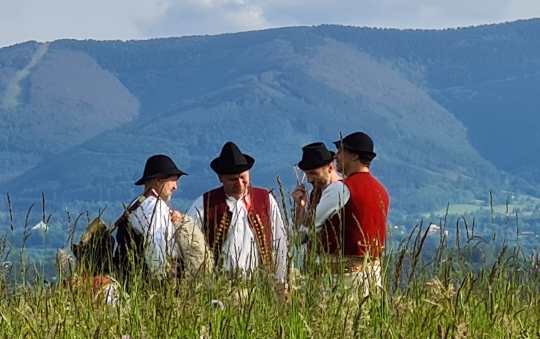|
Ruky na Dudách offers a thrilling mass of grainy instruments and strong vocals, in music of the Moravian-Silesian Beskyd mountains in eastern Czechia (the Czech Republic). Bagpipe, fiddles, kontra (rhythm viola), koncovka, hammered dulcimer, trúba (long wooden Carpathian trumpet), high-pitched pistalka (wooden whistle), various gutsy folk percussion instruments and more, are joined by wild full-voiced male and female singing.
It’s music full of the energy and spirit of village tradition, but these aren’t field recordings; they’re tracks, new and from previous releases, featuring bagpiper Vlastimil Bjaček in arrangements by his longtime colleague, musician, ethnomusicologist and producer Marian Freidl.
Bjaček plays the Moravian form of the instrument which, like the other two Czech bagpipes, is bellows-blown with a single drone and a single-reed, cylindrical-bored chanter played with closed-fingering. The music of this gajdy is shaped by its scale - its chanter’s eight notes cover a range of an octave and one, but with a gap of two tones between the bottom two notes.
Fairly unusual in music in general, but very characteristic of the folk music of Slovakia, just over Moravia’s eastern border (and also of the goralska music of the Polish Tatras, not too far further east along Carpathian chain), is the Lydian mode, which is like a major scale but with a sharp fourth (if in C that would be a C major scale with F# instead of F). This east Moravian music also has a strong Lydian flavor; mere national borders don’t limit music.
The Lydian mode is the natural scale of the koncovka, the no-hole overtone whistle that’s associated with animal herders in various parts of Europe. (Sheep and shepherds feature in quite a few of the songs here, as does, among other topics, the frequent Carpathian song-theme of outlaws.) Even the non-Lydian melodies on this album very often show a characteristic ‘mi, re, do’ line-ending sequence.
If that reads as a tad technical, it’s my attempt to understand and explain (to myself, if perhaps not to you, poor reader) one of the attributes of this, and of Slovak folk music, that in conjunction with their textures, wildness and spirit I find so special and appealing. For me they touch the same pleasure centres as does the thrilling, while non-Lydian, sound of the gaitas and singers of Iberia’s Galicia.
As the detailed booklet in Czech and English tells, bagpipes almost became extinct in Moravian music, one of the reasons probably being that when the hammered dulcimer became a frequent part of ensembles with fiddles and other instruments the constant drone of the bagpipe became a limiting factor, and the reedy role of its chanter could be replaced by the clarinet. (A contrast to the Scottish situation where the clarsach was drowned out and replaced by the Highland bagpipe). But the work, playing and instrument-making of a few determined individuals, with inspiration from neighboring regions of Slovakia and Poland, has since the mid-20th century been turning around its decline, at least to some extent.
Taking up the cause, in 2004 Freidl and Bjaček founded the bagpipe-led band RukyNaDudy. Its members feature in much of the music here, and some of the tracks come from the band’s 2014 album, while others are from Friedl’s 2020 album 11 Podob Lásky and from 2016 and 2019 collaborations with other bands and musicians such as fine fiddler the late Jitka Šuranská and her trio. Seven of the total fifteen are newly-recorded. The material is nearly all from Moravia, largely traditional with occasional Freidl originals in like vein. One track, though, “Gajdotta,” is based on two gavottes from Michael Praetorius’s 1612 collection of French dancing-master music; it’s refreshing to hear this sound and energy interpreting music that’s usually played by ensembles from the classical early-music world.
While championing traditions, the music here isn’t restricted when an innovation will make it even stronger; thus, for example, there’s a brief wacky electric guitar play-out to track 4, “Jedě Furman,” ‘a song about a wagoner being attacked by thieves’. Not a work of nostalgia or reconstruction, it’s the spirited revitalizing of material, sounds and techniques that had declined, to make vibrant present-day music.
|
